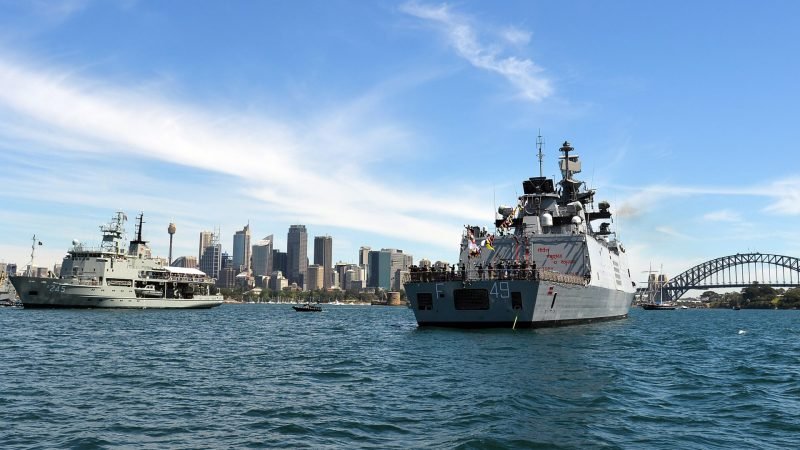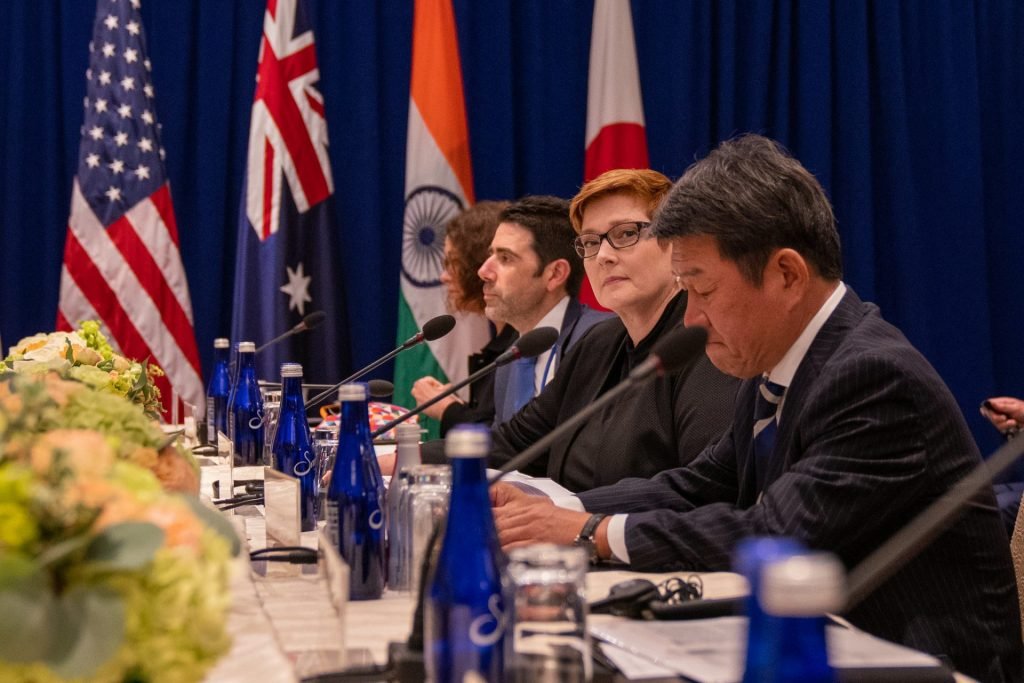Indo-Pacific: Quad and India

Abstract
The ‘Indo-Pacific’ is an emerging geopolitical construct which aims to promote peace, security and stability in the region. This particular region is also known as ‘Asia-Pacific’. But due to changing geopolitical dynamics especially with China and security scenarios in the region; as well as, in the enhancement of maritime domain the focus shifted from land centric to Ocean centric. Thus, Indo-Pacific is a kind of ‘maritime geopolitical construct’ of the 21st century. Which has tremendous potential for economic growth and stability of the region. The need for Indo-Pacific primarily highlighted by Japanese Prime-Minister Shinzo Abe in 2007 in his speech of ‘Confluence of two seas’ at Indian Parliament. His aim was at the maritime security of the region.
There is a major initiative taking place in Indo-Pacific for the security of the overall region; major countries like the USA, Japan, India, and Australia who have discussed and now formulating the ‘Quadrilateral Security dialogue’ which also popularly known as ‘Quad’ for sustainable peace and security in the region. These initiating countries have taken a keen interest in the security of the region and parallel to promote rule of law and tranquillity in the Indo-Pacific.
This research brief focuses upon how the geopolitical transition has taken place from the term ‘Asia-Pacific’ to the ‘Indo-Pacific’? Secondly, the formation and the nature of the quad as well as, its geopolitical and geo-economic dimensions. The quadrilateral countries are major democratic countries in the region; the alliance of such democratic countries would definitely strengthen democracy and its values in the region, as well as respect for International law would be promoted. And thirdly, There are security issues in the region such as human/drugs/arms trafficking, piracy, terrorism/ maritime terrorism, Islamic radicalization etc. Being India as an active partner/member in Quad dialogue, India can collaborate to strengthen collective security efforts with other Quad Countries by Information and intelligence sharing, maritime exercises, logistic exchanges, a technological partnership to build Science and technology capabilities in Defence Sector, Space initiative, Joint patrolling, Anti-piracy operations, Securing International shipping lanes to maintain security and to build peace in Indo-Pacific as well as to serve India’s own national interest.

Transition and concept of Indo-Pacific.
The concept of the Indo-Pacific can be traced back to the 1920s, to the term ‘Indopazifischen Raum’ coined and elucidated by ‘Karl Haushofer’. Haushofer elucidated that, ‘dense Indo-Pacific concentration of humanity and the cultural empire of India and China, which are geographically sheltered behind the protective veil of the offshore island arcs’. In 1944, ‘Nikolas Spykman’ termed the Indo-Pacific as the ‘circumferential maritime highway which links the whole area together in terms of sea power.’
In its most contemporary form and usage, the term Indo-Pacific was first used by a retired Indian naval officer, Capt. (Dr) Gurpreet Khurana in an article titled ‘Security of sea lines: prospect for India-Japan co-operation’ where he illustrates the concept in the context of Indo-Japanese cooperation in Indian and Pacific oceans to secure sea lines of communication. In his article, he emphasized on Security threats in the Indian Ocean region, Arabian sea and how these threats are impacting on Japanese trade. He also elaborates that International trade of East Asian countries, ASEAN countries and especially Japan’s is dependent on international shipping lanes of communication (ISLoC) in Indian ocean and Pacific ocean, that’s why there is a scope to develop maritime security relations between two states.
The transition from the Asia-Pacific to Indo-Pacific first officially started when Japanese Prime Minister Shinzo Abe visited India in 2007, he visited Indian Parliament and made the famous speech of ‘Confluence of two Seas’ inspired by the seventeenth-century book by the Mughal prince ‘Dara Shikoh’. He proposed the formation of ‘The arc of freedom and prosperity’ in broader Asia, comprising an immense network, incorporating the United States of America and Australia. The Indian and Pacific Oceans alluding to the formation of a ‘broader Asia’. He added that as maritime states, both India and Japan have vital interests in the security of sea lanes.
In 2011, Hillary Clinton, former US Secretary of State wrote an article in the Foreign Policy magazine about the significant connection between Indian and Pacific Oceans to announce the United States’ pivot to the region and introduced the word ‘Indo-Pacific’ there; followed by Australia who adopted the term in 2013 Defense White Paper and foreign policy white paper. Onwards that, Indo-Pacific term gained credence in the strategic community of Canberra, Tokyo, New Delhi, and Washington. In 2013, Australian defence white paper 2013, officially used the term Indo-Pacific. In 2018, at Shangri-la dialogue, Indian prime minister Narendra Modi used term Indo-Pacific and in November 2019, Prime-Minister Narendra Modi proposed an ‘Indo-Pacific Ocean’s Initiative’, thus, India has also accepted and familiarized itself with this terminology. The earlier Asia-Pacific region used to consider from the Strait of Malacca to the Western Pacific. Unlike, Indo-Pacific is comparatively broad. It is the confluence of the Indian and Pacific Ocean. India considers it from the Eastern shores of Africa to the West coast of America due to which its strategic geography is too vast. It means the area covers the all littoral countries of the Indian and Pacific Ocean.

The Quad its origin and role of India
The peace and security of this region is extremely important for the stability and prosperity of the region. Majority of Indo-Pacific countries are agreeing with free, open, and inclusive Indo-Pacific. The rule of law must be maintained in the region. Since the past several years’ China is taking aggressive offensive posture into the South China Sea (SCS) it denies freedom of navigation in the region. It has developed artificial islands which cause massive destruction of the ocean and marine environment of the region. The SCS is a significant region for maritime commerce, it is a most popular and busiest trade route for the world and it has a tremendous amount of natural resources as well which deliberately increases its geo-economic and geo-strategic importance in the world. Thus, China’s aggressive posture and naval assertion harm the interest of littoral countries and extra-regional powers.
USA, India, Australia, Japan are four major democratic powers in the Indo-Pacific region, they have initiated ‘Quadrilateral Security dialogue’ popularly known as ‘Quad’. Basically the Indo-Pacific and Quad are two different things which need to be understood. Indo-Pacific is a geopolitical construct and Quad is a grouping of four major Indo-Pacific countries. The Concept of Quad emerged in 2007 and revive in 2017. Quad 2.0 is an initiative by four countries to maintain peace and prosperity in the region. The promotion and respect of International law is the ultimate aim of Quad. It also has economic, geopolitical and strategic aspects. As we have seen, the Indo-Pacific region is a significant for Economic prosperity, global trade route, the emergence of ASEAN countries as major economic powers, the economic growth of Japan, Taiwan, China, and India increases the geo-economic importance of the region.
The origin of Quad can be traced back to the tsunami incident in Indo-Pacific region particularly in Sri-Lanka, Andaman and Nicobar Islands, Coast of India, Indonesia etc.. On 29 December 2004, US President George W. Bush announced that The US, Australia, Japan, and India would set up an international coalition to coordinate the massive efforts required. The emergence of Quad was clearly for the Humanitarian Assistance and disaster relief operations in the Indo-Pacific region. In the contemporary Strategic talks on ‘Quad’, we can draw various parallels in the discussion like Economic, Political, Security, Strategic, Co-operation in the field of Sci-tech, and Climate change etc.. As it is need of time, its today’s geostrategic demand. It also can be seen from the perspective of ‘Balance of power in the Indo-pacific region’. As India and other powers are facing assertions of China in the region. Thus, it can be one of the aspects of it. One of the most important points needs to be understood that, The Quad not in formal stage, it is still in informal stage however talks, discussions and debates are going on between the four countries on track 1, 1.5 and on Track 2 dialogues.

India can strengthen its military capabilities and improve the interoperability of forces by doing bilateral military exercises with quad countries. India has been doing bilateral military exercises with Quad countries. Onwards, the complete official formulation of Quad, countries would be able to exercise and improve interoperability between the forces, share information of the region, gathering intelligence, they can also be the collective partner in research and development of defence technologies, Cyber and space capabilities. India’s role would not be purely military rather it would be a comprehensive partnership within Quad. There are security issues in the region which affects the economy of the region. Piracy near the Western coast of Africa, Arabian sea and near Strait of Malacca, Arms, human, and drugs trafficking in the region promotes terrorism and concerns to human security. The Islamic terrorist group ‘Abu Sayyaf’ is a security concern for the East Asian region which needs to be tackled as soon as possible for the stability of the region. Such ‘non-state’ actors can harm the ISLoC which has the potential to economically destabilize the region. Such terrorist organizations can create another Syrian situation in East Asia. Thus, it’s important to sit on a table, discuss the issues, make policy outlook, and introduce the strategy for peace and security.
India has also signed a ‘logistic exchange agreement’ also known as LEMOA, MLEA and ACSA with the USA, Australia and Japan respectively. Which will be beneficial to Indian forces for its presence, interoperability and logistical support in the region.
By considering threats from State and Non-State Actors, the stability and peace of the region is at stake. Yet, the Quad is just a name, it’s not on the ground. Thus, it is the need of time to officially formulate the ‘Quad’ in the Indo-Pacific to maintain ruled based world order and peaceful region for global and India’s national interest.
References
Abe, Shinzo (22, August 2007). ‘Confluence of seas’. Speech by Japanese Prime minister Shinzo Abe in Indian parliament. Retrieved From- https://www.mofa.go.jp/region/asia-paci/pmv0708/speech-2.html.
Haidar S (2017) After the tsunami how the Quad was born, by The Hindu, Retrieved from- https://www.thehindu.com/opinion/op-ed/after-the-tsunami/article20461149.ece#:~:text=The%20plan%20for%20a%20meeting,visited%20Tokyo%20in%20December%202006.&text=The%20idea%20born%20of%20such,its%20meeting%20in%20May%202007
Lawrence W. P. (2014). The emergent vistas of the Indo-Pacific. In ‘Indo-Pacific region: political and strategic prospects’ editors Rajiv K.Bhatia, Vijay Sakhuja (Page-5-16), ICWA, published by Vij books India Pvt Ltd, New Delhi, India.
Nidhi P.(2018). India’s Foray into the Indo-Pacific: Embracing Ambiguity through Strategic Autonomy. Retrieved from- https://www.ide.go.jp/library/Japanese/Publish/Download/Report/2018/pdf/2018_2_40_011_ch07.pdf
Parmar S. (September 2020) talk on Maritime dynamics in Indo-Pacific conducted by NIICE, Nepal, Date- 11 Sept 2020.


















